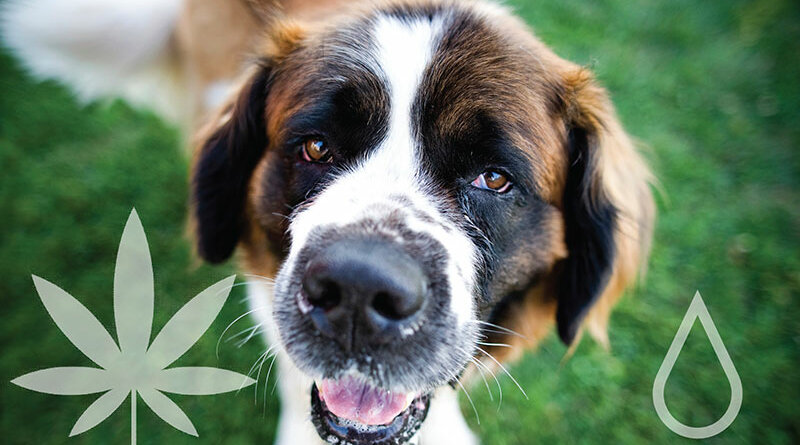What’s New in Medical Cannabis for Dogs?
5 Key Takeaways
• Cannabis is the single most significant new development in veterinary pharmaceuticals to emerge in at least the last 20 years.
• Currently, CBD has been demonstrated to be effective only for the treatment of osteoarthritis and some forms of epilepsy.
• While both humans and dogs have endocannabinoid systems, they respond differently to CBD based on the configurations of their individual systems; therefore, research results for one species aren’t necessarily transferrable to the other.
• In deciding which products to use with their companion animals, consumers should be guided by a product’s certificate of analysis, which verifies its contents and purity.
GET THE BARK NEWSLETTER IN YOUR INBOX!
Sign up and get the answers to your questions.
• Until the federal government takes a uniform position on the legal status of cannabis, the regulation of products in the marketplace will continue to lag behind the rate at which products are being researched and developed.
Over the past few years, demand for cannabidiol (CBD)-based products for both humans and companion animals has exploded, far outpacing the research needed to identify and clarify CBD’s strengths, weaknesses and—most critically for pet owners—its clinical use by veterinarians.
Despite the literally thousands of papers that have been published on how humans and 24 species of animals respond to cannabinoids, we still don’t know with any certainty what CBD is useful for, or how it should be used. (There are a few exceptions, notably related to the treatment of osteoarthritis, some forms of epilepsy and—strongly suggested but not yet scientifically demonstrated—anxiety.)
Regardless, based on a recommendation from a friend, a relative or social media, people have been buying CBD products and using them with their dogs. In 2015, as a service to our readers, we published Medical Cannabis: Is It Good For Our Dogs?; Dr. Robert Silver, an acknowledged expert on the subject, generously provided his insights to that coverage. So, when we wanted to know where we are now, we naturally turned to Dr. Silver.
Bark: What do you consider to be the most significant changes in regulation and research since we spoke in 2015?
Rob Silver: In terms of regulation, the 2018 Farm Bill and Hemp Farming Act have passed. Technically, the Farm Bill allowed the hemp agricultural industry to grow and transport their products, but nothing definitive has been set up to regulate actual CBD products.
We are still waiting for the FDA to finish their discovery phase before they create the regulatory standards that the industry will follow. In the meantime, the industry is doing a certain amount of self-regulation, with certificates of analysis (CoA) being more commonly used to verify the contents of a product and its purity.
As far as research goes, the scope of cannabis research in veterinary species is limited right now to only one major condition being well suited for CBD (osteoarthritis, or OA), but that will change over time as more studies are completed in more diverse realms.
The majority of papers document the ability of CBD—as an isolate or an emulsion; in a soft-chew; or as a full-spectrum, oil-based tincture—to remediate OA in the dog at doses that are fairly high. These studies used something called the Canine Brief Pain Inventory, which has been validated as an objective measurement tool, to document the improvement in mobility.
However, none used other measuring tools, such as force plate analysis, thermography or measurement of reduced inflammation. And although some were placebo-controlled, for the most part, the studies were performed on relatively small study samples. Another detail: All of these studies were funded by the company whose CBD product was being used as the test article, thus introducing economic bias.
Several published studies from Canada and Europe report on the use of a mixture of CBD and THC to measure the safety and pharmacokinetics of these compounds in the dog. They found that when THC is included at low-dose levels, introduced very gradually and combined with higher doses of CBD, it can be used safely.
No improved benefits from the addition of higher amounts of THC have been experimentally documented yet in terms of pain, inflammation, mobility, anxiety or neurologic problems, though a treasure trove of anecdotal information exists on products to treat cancer and to remediate cancer therapy’s side effects. Due to the federal Schedule 1 status of THC, there are no objective efficacy studies on the use of THC in the dog, although pharmacokinetic and safety studies exist.
CBD and Idiopathic Canine Epilepsy
A study undertaken in the neurology department at Colorado State University measured the ability of a full-spectrum CBD product to reduce the frequency and severity of breakthrough seizures in the canine epilepsy patient with an idiopathic, treatment-resistant form of the disease. While the results were not as good as the researchers had hoped, they did show some limited improvement with CBD in these difficult-to-treat patients. The study reported an improvement (not an elimination) in about two-thirds of the subjects when treated with a dose of CBD twice a day. The researchers are repeating the study, now funded by the AKC Canine Health Foundation, with a higher dose twice a day to see if that can further reduce the incidence of breakthrough seizures in dogs who are already on strong anti-convulsant drugs.
B: For human use, CBD-related products have proliferated in number, type and degree of quality control during the past few years. How about CBD in products for companion animals? How do we distinguish quality from questionable?
RS: CBD products for pets have proliferated every bit as rapidly as for their human companions. With such a wide-ranging array of products, quality control has definitely become a significant problem. To date, only one paper has been published comparing the CoA of 29 products on not just cannabinoid content but also, on residual solvents, microbial analysis, heavy metals, pesticide residues and terpenes [aromatic compounds that give plants a distinctive scent]. In general, the products examined were what they were advertised to be, with only a few not meeting label claims or containing troublesome contaminants.
I am teaching veterinarians how to read a CoA and how to look for quality in a laboratory based on ISO/IEC 17025 accreditation. This is the only reliable way to ensure that the product selected contains what it claims to, and is free of contamination and toxins. Trusting the word of the company as regards its product quality is a slippery slope.
Products that have a study associated with them may be more reliable than products that do not, as it generally (but not always) means that the company is willing to spend money to support that its product works and is safe.
B: Do you see a potential for CBD to be added to commercial dog food?
RS: It is highly unlikely that CBD will be in pet food in the next five years, although I might live to eat those words (or that pet food!). Regulatory agencies move slowly, and safety studies need to be conducted to prove that the long-term ingestion of CBD is safe for dogs. The FDA’s Center for Veterinary Medicine (CVM) has not even approved hemp seed oil or hemp seed protein for dogs, those parts of the cannabis plant that don’t contain any CBD or THC.
Currently, a nonprofit, the Hemp Feed Coalition, is working to submit the appropriate paperwork to the CVM for the approval of these non-cannabinoid-bearing parts of the plant for dogs, cats and horses. We expect approval to go through this year, although, since the FDA has been focused on Covid-19, it may be 2022 before approval for these pet food ingredients comes through.
B: Generally speaking, how similar (or different) are people and dogs in their responses to CBD in its various forms? For example, could the results of a study on CBD’s use for a human medical condition be applied companion animals?
RS: Because humans and dogs both have endocannabinoid systems, they both respond to the effects of cannabinoids based on their binding to membrane-receptor systems that orchestrate and control the body’s activities. For example, pain, inflammation, reduction of tumor growth, neurologic function (in terms of anxiety or uncontrolled neurologic activity, as with epilepsy), gastrointestinal inflammation and GI motility disorders, even dermatologic conditions, are all under the control of these systems.
Obviously, with things like cancer and seizures, the body’s own endocannabinoid system has failed to control the pathology, so adding CBD and other phytocannabinoids will stimulate the body’s mechanisms to improve quality of life.
However, while all animals and most invertebrates have this endocannabinoid system, the density, anatomical distribution and binding coefficients of these molecules differ from species to species, and even within species on an individual basis. This is a long-winded way to say that you can’t really relate the exact results of a study in one species to another species, although they might be the same or similar.
I have seen studies that show that full spectrum has more potency than isolate to reduce the growth of cancer cell lines. To complicate things even more, a recently published study shows that CBD is more effective than CBDA (cannabidiolic acid) against a number of cancer cell lines that affect dogs.
There are many configurations of phytocannabinoids (major, minor, acidic and neutral), terpenes and flavonoids (which currently are not being measured, but play an important role in pain management and inflammation) in the whole plant extract (full spectrum/broad spectrum), in addition to isolates of each of these constituents of cannabis. It’s impossible, this early in the research, to say that one is superior to another for every species, individual or condition “out there.” Being guided by the limited research that is available is the best way to figure out what to use for what species and what condition. Other than that, it’s all shoot-from-the-hip anecdotal in terms of which products to use.
What works for cancer may not work for another problem. What works for dogs may not work for cats or horses, or may work, but not as well at the same dosage. There needs to be a ton more research into each of these things to learn how to specifically treat a given condition in a given species.
So, until these studies are conducted and published, which will be happening over the next five to 10 years, the best way to treat any condition is to use a shotgun approach with a full spectrum or broad spectrum herbal extract from cannabis, and to start with a reasonably low dose and after a few weeks, escalate the dosage to achieve the clinical benefits desired.
Read more: For more on the evolution of new CBD veterinary therapeutics.
B: What’s your forecast for the use of CBD with dogs/companion animals in the coming years?
RS: The pet CBD market is flooded with redundant products, and companies are scrambling to find ways to differentiate their products from the crowd. As a result, we are seeing an interest in the minor cannabinoids—CBG or CBC—and the acidic, raw cannabinoids such as THCA, CBDA, CBGA and so forth. Unfortunately, there’s not much research to support their use for conditions, species and dosages. It’s a lot like it was five years ago, when CBD oil became the hottest thing since who knows what? Companies that want to see increased sales of these “alt-cannabinoids” will have to spend some money to conduct research so we can know objectively how to use them.
We will also see products from plants that have been genetically modified to have increased amounts of these cannabinoids in a whole-plant extract. They may have more potency than a synthetic product made from multiple isolates of alt-cannabinoids combined artificially rather than made by mother nature.
In addition to the alt-cannabinoids, terpenes can also increase potency and absorption and direct the efficacy of the formula to a specific organ system or treat a specific condition. We are seeing companies offering to spike formulas with terpene blends aimed at certain results, such as calming, pain management and cancer. We will see more of these advanced formulas for pets once we know more about what these non-CBD components do. Most formulas will still contain CBD as a base and will add the specific terpenes and alt-cannabinoids to make them unique and, one hopes, more efficacious.
As mentioned, we will see the approval of hemp ingredients in pet foods, and I suspect that there will also be medicated feeds that can contain the cannabinoids, although they’re unlikely to contain THC in much of any amount.
We will see a proliferation of product-dosage formats, with inhalers, transdermals, beadlets and non-greasy topicals as more convenient, better forms for absorption. We will also see infused bottled water for pets, so that on hikes, the people can give their pet a drink of CBD to help with mobility and stamina on the trail.
We will see FDA-approved products for pets using patented synthetic cannabinoids (the FDA likes synthetic cannabinoids; they’re usually the only type the agency will allow in an approved product).
We will see veterinary cannabis being taught in veterinary schools. Cannabis is the single most significant new development in therapeutics to emerge in at least 20 years. (Heartworm medication was probably the last significant veterinary therapeutic.)
Finally, perhaps in the next five years, the FDA will finally make up its mind how to regulate CBD products—and possibly, cannabis in general—for both people and their companion animals.




